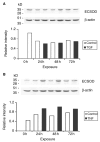Extracellular superoxide dismutase has a highly specific localization in idiopathic pulmonary fibrosis/usual interstitial pneumonia
- PMID: 16842247
- PMCID: PMC1847412
- DOI: 10.1111/j.1365-2559.2006.02470.x
Extracellular superoxide dismutase has a highly specific localization in idiopathic pulmonary fibrosis/usual interstitial pneumonia
Abstract
Aims: Recent studies suggest the importance of oxidant stress in the progression of pulmonary fibrosis. The aim of this study was to investigate extracellular superoxide dismutase (ECSOD), the major antioxidant enzyme of the extracellular matrix of human lung, in biopsy-proven idiopathic pulmonary fibrosis (IPF) related to usual interstitial pneumonia (UIP).
Methods and results: Fibrotic areas and fibroblastic foci in UIP lungs were notable for absence of ECSOD by immunohistochemistry. Western blotting showed significantly lowered immunoreactivity of ECSOD in fibrotic compared with non-fibrotic areas of the diseased lung. The only cell type that showed intense ECSOD positivity in UIP was the interstitial mast cell. In order to investigate the mechanism for ECSOD depletion in fibrotic areas, alveolar epithelial cells were exposed to tumour necrosis factor-alpha and transforming growth factor (TGF)-beta1; TGF-beta suggested a trend towards decreased synthesis. Patients with UIP were also assessed to determine whether this disease is associated with a naturally occurring mutation in ECSOD (Arg213Gly) which leads to a loss of tissue binding of ECSOD. No significant differences could be found in the allele or genotype frequencies of this polymorphism between 63 UIP patients and 61 control subjects.
Conclusion: Overall, consistent with several other antioxidant enzymes, ECSOD is very low in fibrotic areas of UIP, which may further increase the oxidant burden in this disease.
Figures




Similar articles
-
Oxidative stress contributes to the induction and persistence of TGF-β1 induced pulmonary fibrosis.Int J Biochem Cell Biol. 2011 Aug;43(8):1122-33. doi: 10.1016/j.biocel.2011.04.005. Epub 2011 Apr 14. Int J Biochem Cell Biol. 2011. PMID: 21514399
-
Cell-specific regulation of gamma-glutamylcysteine synthetase in human interstitial lung diseases.Hum Pathol. 2004 Jul;35(7):832-9. doi: 10.1016/j.humpath.2004.03.010. Hum Pathol. 2004. PMID: 15257546
-
Usual interstitial pneumonia and smoking-related interstitial fibrosis display epithelial to mesenchymal transition in fibroblastic foci.Respir Med. 2014 Sep;108(9):1377-86. doi: 10.1016/j.rmed.2014.06.008. Epub 2014 Jul 17. Respir Med. 2014. PMID: 25066934
-
[Idiopathic pulmonary fibrosis].Vnitr Lek. 2005 Dec;51(12):1375-84. Vnitr Lek. 2005. PMID: 16430105 Review. Czech.
-
Extracellular superoxide dismutase in pulmonary fibrosis.Antioxid Redox Signal. 2008 Feb;10(2):343-54. doi: 10.1089/ars.2007.1908. Antioxid Redox Signal. 2008. PMID: 17999630 Free PMC article. Review.
Cited by
-
Lung-Targeted Delivery of Dimethyl Fumarate Promotes the Reversal of Age-Dependent Established Lung Fibrosis.Antioxidants (Basel). 2022 Feb 28;11(3):492. doi: 10.3390/antiox11030492. Antioxidants (Basel). 2022. PMID: 35326142 Free PMC article.
-
Evaluation of oxidative stress biomarkers in idiopathic pulmonary fibrosis and therapeutic applications: a systematic review.Respir Res. 2018 Mar 27;19(1):51. doi: 10.1186/s12931-018-0754-7. Respir Res. 2018. PMID: 29587761 Free PMC article.
-
Interstitial lung diseases-can pathologists arrive at an etiology-based diagnosis? A critical update.Virchows Arch. 2013 Jan;462(1):1-26. doi: 10.1007/s00428-012-1305-0. Epub 2012 Dec 7. Virchows Arch. 2013. PMID: 23224047 Free PMC article. Review.
-
Molecular and cellular mechanisms of pulmonary fibrosis.Fibrogenesis Tissue Repair. 2012 Jul 23;5(1):11. doi: 10.1186/1755-1536-5-11. Fibrogenesis Tissue Repair. 2012. PMID: 22824096 Free PMC article.
-
Oxidative damage and TGF-β differentially induce lung epithelial cell sonic hedgehog and tenascin-C expression: implications for the regulation of lung remodelling in idiopathic interstitial lung disease.Int J Exp Pathol. 2011 Feb;92(1):8-17. doi: 10.1111/j.1365-2613.2010.00743.x. Epub 2010 Oct 29. Int J Exp Pathol. 2011. PMID: 21039988 Free PMC article.
References
-
- Lakari E, Soini Y, Saily M, et al. Inducible nitric oxide synthase, but not xanthine oxidase, is highly expressed in interstitial pneumonias and granulomatous diseases of human lung. Am J Clin Pathol. 2002;117:132–142. - PubMed
-
- Saleh D, Barnes PJ, Giaid A. Increased production of the potent oxidant peroxynitrite in the lungs of patients with idiopathic pulmonary fibrosis. Am J Respir Crit Care Med. 1997;155:1763–1769. - PubMed
-
- Strausz J, Muller-Quernheim J, Steppling H, Ferlinz R. Oxygen radical production by alveolar inflammatory cells in idiopathic pulmonary fibrosis. Am Rev Respir Dis. 1990;141:124–128. - PubMed
-
- Fattman CL, Schaefer LM, Oury TD. Extracellular superoxide dismutase in biology and medicine. Free Radic Biol Med. 2003;35:236–256. - PubMed
Publication types
MeSH terms
Substances
Grants and funding
LinkOut - more resources
Full Text Sources
Other Literature Sources
Medical
Miscellaneous

